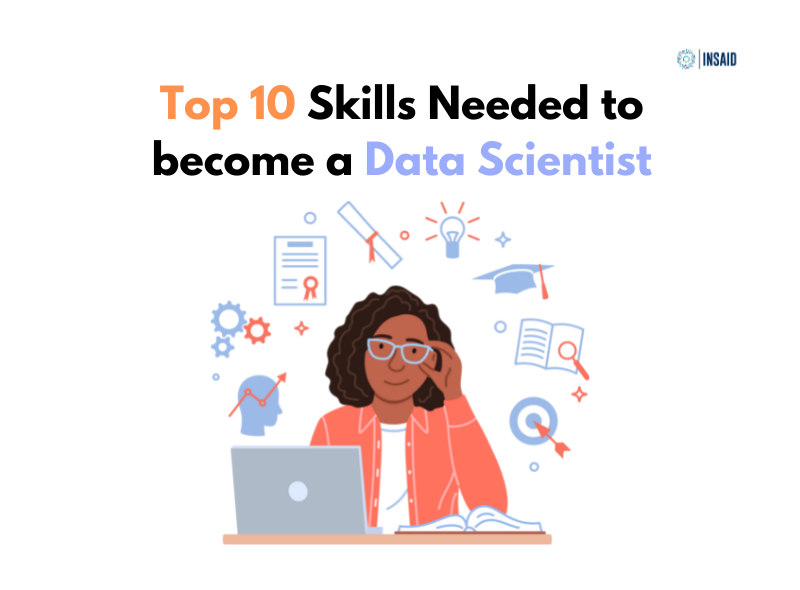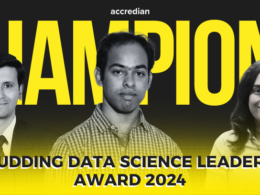Data Science is a field with a steep learning curve, that is, you get to learn a lot of things in a very short span of time. A Data Scientist must be fluent in a variety of computer languages and statistical computations, as well as possess good interpersonal and communication skills. So what are these skills? Let’s dive deep to find out.
Top Skills Required For Data Scientist
1. Fundamentals of Data Science
Understanding the principles of data science, machine learning, and artificial intelligence as a whole is the first and most crucial skill you’ll need. Understand topics such as:
- What is the difference between deep learning and machine learning?
- Data science, business analytics and data engineering + the differences between them.
- Terminologies and tools that are commonly used
- What is the difference between supervised and unsupervised learning?
- Problems of classification vs regression
2. Deep knowledge of mathematical concepts: statistics and probability
Before you can create high-quality models, you need to understand statistics. Machine Learning begins with statistics and evolves further.
Statistics is defined as the study of the collection, analysis, interpretation, presentation, and organising of data, according to experts. As a result, it should come as no surprise that data scientists require statistical knowledge in their profession.
It is necessary to understand the concepts of descriptive statistics such as mean, median, mode, variance and standard deviation.
3. Knowledge of Programming Languages
Data scientists must be proficient in advanced statistical modelling tools and have a deep understanding and knowledge of programming, in addition to having a strong foundation in mathematics and statistics.
There are a variety of programming languages that are preferred for the role of a data scientist.
Some of them are:
Python: Python can handle everything from data mining to website development to running embedded systems in a single language.
It is a Python data analysis package that can do everything from import data from Excel spreadsheets to plot data with histograms and box plots. Data processing, reading, aggregation and visualisation are all made simple with this library.
R Programming: R is a software package that includes functions for data manipulation, calculation and graphical display. In comparison to Python, R is more widely used in academic environments.
Machine learning algorithms may be implemented fast and easily, and the software includes a number of statistical and graphical approaches, including linear and non-linear modelling, classical statistical tests, time-series analysis, classification and clustering.
4. Experience in Data Extraction, Transformation and Loading
Assume we have several data sources, such as MySQL, MongoDB, Google Analytics, etc. (examples of different databases available). You must extract data from such sources and then transform it so that it may be stored in a suitable format or structure for querying and analysis.
Finally, you must load the data into the Data Warehouse (a type of data management system designed to enable and support Business Intelligence activities, particularly analytics), which will be used to analyse it.
5. Knowledge of Data Wrangling and Data Exploration
Data Wrangling is the process of cleaning and unifying messy and complex data collections for easy access and analysis. Take, for example, the act of packing your luggage.
What happens if you stuff your entire wardrobe into your bag? You’ll save a few minutes, but it’s not the most efficient method, and your clothes will be ruined as well. Instead, spend a few minutes ironing and stacking your clothes
The initial phase in your data analysis process is Exploratory Data Analysis (EDA). Here, you’ll figure out how to make sense of the data you have, as well as what questions you want to ask and how to phrase them, as well as how to best modify your data sources to get the answers to the problem currently being considered.
This is done by looking at patterns, trends, outliers, unexpected outcomes and so on. Data manipulation and wrangling, on the other hand, can take a long time but can ultimately help you make better data-driven judgments.
Missing value imputation, outlier treatment, correcting data types, scaling and transformation are some of the common data manipulation and wrangling techniques used.
So, a data scientist must be familiar and confident in concepts of data wrangling and data exploration.
6. Knowledge of Data Visualisation

One of the skills that Data Scientists must acquire in order to connect more effectively with end-users is data visualisation. There are programs available, including Tableau, Power BI, Qlik Sense and many others, that have a user-friendly interface.
Data visualisation is more of an art than a pre-programmed procedure. There is no such thing as a “one-size-fits-all” solution here. A Data Visualization expert understands how to use graphics to convey a message.
To begin, you must be comfortable with basic plots such as histograms, bar charts and pie charts, before moving on to more advanced charts such as waterfall charts, thermometer charts and so on.
During the exploratory data analysis stage, these graphs are extremely useful.
7. Comprehensive Knowledge of Machine Learning
Machine learning is a must-have ability for any data scientist. Predictive models are created using machine learning. If you want to forecast how many clients you’ll have in the upcoming month based on the previous month’s data, for example, you’ll need to employ machine learning techniques.
You can begin with simple linear and logistic regression models before progressing to sophisticated ensemble models such as Random Forest, XGBoost, CatBoost and others.
Knowing the code for these algorithms is useful, but understanding how they operate is more vital. This will aid hyperparameter adjustment and, ultimately, the creation of a model with a low error rate.
By the way, you can also check out this video to understand better. Click below!
8. Good Problem Solving Skills and Thorough Knowledge of Data Structures and Algorithms
Data Scientists must have good problem-solving skills and they must be able to quickly analyse any error in the training model and fix them quickly. They must be able to come up with multiple solutions to a single problem.
They must also be well versed with advanced data structures and algorithms as they can often be helpful in designing the training model.
9. Good Communication Skills
Data can’t talk unless it’s been manipulated, so a good Data Scientist must be able to communicate effectively.
Communication may make all the difference in the outcome of a project, whether it’s communicating to your team what actions you want to take to get from point A to point B with the data or presenting a presentation to corporate leadership.
In most data scientist professions, excellent communication skills are required. You’ll need to grasp business requirements or the problem at hand as a data scientist, as well as probe stakeholders for more data and communicate crucial data insights.
10. Curiosity and Desire for a steep learning curve
Data science technologies and frameworks grow at such a rapid pace that mastering any single one is pointless. Rather than striving for perfection, you should:
- Focus on developing the patience
- Discipline to teach oneself new skills
- Swiftly grasp new concepts
One of the most important soft skills of a data scientist is the ability to keep asking questions. You can follow all of the processes of the machine learning project lifecycle if you’re monotonous, but you won’t be able to attain the final goal and justify your results.
 Pin
PinIf you liked reading this blog and would love to explore more content like this, check out our blog page, especially curated for you!






